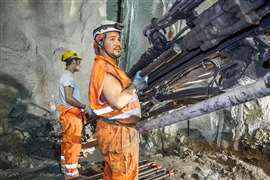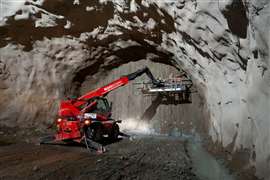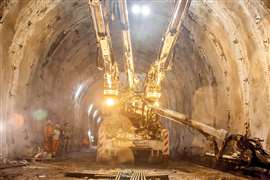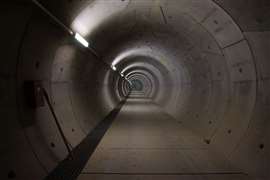The challenges of building the world’s longest railway tunnel
07 September 2023
The Brenner Base Tunnel will form the main part of a 64 km mega-tunnel under the Alps between Austria and Italy, making it the world’s longest railway tunnel. Chief engineer David Marini tells Lucy Barnard why building an exploratory tunnel is making the project quicker and safer.
For David Marini, getting onto site is becoming increasingly time consuming.
After driving through a network of small tunnels in his Fiat Panda to reach a main tunnel access point, Marini joins groups of workers climbing onto a small train which slowly winds its way through miles of illuminated grey concrete tube before reaching its destination deep under the Italian Alps.
For Marini, chief engineer at the company in charge of building the world’s longest railway tunnel between Austria and Italy, the current hour-long commute is a sign of progress on a 25-year long mega project.
The Brenner Base Tunnel, which will eventually run for 55 kilometers underneath the mountains between Innsbruck in Austria and Fortezza in Italy and connect with the existing 12.7km Inn Valley Tunnel to form a 64-kilometer mega-tunnel, started construction in 2007 and is not expected to be completed until 2032.
 Miners use a drilling jambo in Mules. Photo: BBT
Miners use a drilling jambo in Mules. Photo: BBT
“There are many challenges with this project,” says Marini. “It’s a big challenge to be working underground for eight hours of the day in these difficult situations. Currently it takes an hour to reach the tunnel boring machine because the lengths to be excavated are very long. The people working on it spend eight hours a day together in the TBM, usually in groups of fifteen.”
“A tunnel boring machine works 24 hours a day, seven days a week,” Marini says. “We usually have two main shifts in the day – so 16-20 hours for excavation and four hours for maintenance work.”
Currently three TBMs are active on the project, worming their way slowly through the rock underneath the Tyrol: Ida and Lilia, which have been slowly excavating twin 8.1km tunnels between Ahrental and Navis since the start of 2023; and Flavia which has been digging the 14km western main tunnel from the Iscaro River Underpass in Italy to the Austrian border since 2019 alongside its twin Virginia, which completed its journey in April 2023.
All function as a ‘mobile factory,’ boring through rock and removing spoils from the front and installing pre-cast concrete segments to support the tunnel excavation at the rear.
But the complex geology of the Brenner Pass tunnel area which runs and through the main geological fault line between the Eurasian and Adriatic tectonic plates means that for around half of the tunnel, the rock is so fractured and unstable that tunnel boring machines cannot be used in case the tunnel collapses and the machine becomes stuck.
Geological fault line
“We’re excavating in very deep conditions – sometimes 1,720 meters below the surface. It means that the geological conditions on the surface can be very different from those underground,” says Marini. “In stable material, I can drill a hole and the pressure on the excavation area is very low. But when you have a fault zone, you have big pressures and convergences, and it can be very unstable.”
 Excavating through the Periadriatic fault. Photo: BBT
Excavating through the Periadriatic fault. Photo: BBT
To find out what lies so far beneath the ground, the team used the results of prospection studies that had been made in the area for decades. They supplemented this with geo-radar and geo-seismic imaging as well as sinking 35 km of boreholes along the proposed route, sometimes taking samples of the rock for analysis, sometimes relying on the data from the drilling itself.
“It is very important to be on site in the field and to take decisions in the field to see how the rock is reacting,” says Marini. “In the fault zone, the geological and geo-mechanical information showed that there were big convergences. It means that when you excavate the borehole, the hole will get smaller. The rock is deteriorated, it is loose material like clay. To excavate in these conditions, we had to use tentative solutions.”
The tentative solution the team came up with, says Marini, was to drill a 5-metre diameter exploratory tunnel running between the two main tunnels but 12 metres below them to get a fuller idea of exactly where the problem zones lie.
The procedure, which Marini says is not unusual for major tunnel builds in Austria and Italy, also meant that the exploratory tunnel could then be used to remove spoils on conveyors and to deliver pre-cast tunnel elements during the construction of the main tunnel tubes. Moreover, when the tunnel is in operation, the exploratory tunnel can be used for drainage and maintenance.
“Even with the boreholes and the information from the surface, we knew we did not have that much information,” says Marini. “With an exploratory tunnel you have more certainty and lower risk during the excavation of the main tunnels.”
Why build an exploratory tunnel
BBT, which is a European public limited company 50% owned by OBB, the Austrian national railway operator and 50% by a joint venture company led by Italian railway operator RFI, also calculates that the additional time and money spent excavating the exploratory tunnel can be offset by the resulting reduced construction costs and times.
Work on the exploratory tunnel began in 2007 using gripper tunnel boring machines where possible, to drill into the stable rock at the Italian and Austrian tunnel entrances. By 2011, the excavation reached the fault zone and work slowed as the team switched to other methods, painstakingly digging through the unstable loose clay for month after month.
 Drilling jumbo at work in Mules. Photo: BBT
Drilling jumbo at work in Mules. Photo: BBT
“We started the excavation of the exploratory tunnel in the fault zone in 2011 and it took almost a year to get through it,” Marini says. “Originally we thought it would be 500 metres long – but in the end it turned out to be 800 metres.”
For the sections where TBMs could not be used, Marini says, the teams excavating the exploratory tunnel have had to adopt a flexible approach, analysing the geology before pressing ahead with traditional drilling and blasting techniques.
He says two main methods are being used: the New Austrian Tunnelling method where ground support, including the use of sprayed concrete linings, is added as excavation progresses; or the Adeco method where contractors systematically reinforce the face of the tunnel before drilling into it.
“The main situation is that we tried to work together with the rock,” Marini says. “We took a lot of measurements during the excavation, evaluated them in the field, and after that we put in place the lining. In order to do that you have to have contracts which allow this flexible method. In our case, the contracts signed by construction companies make it clear that it is BBT’s role as planner and designer to define these construction situations which allows us to react in real time and choose the appropriate installation of materials.”
TBMs get stuck
Nonetheless, despite all of this, Marini says that there were still a number of occasions where, despite all of these precautions, the TBMs working on the exploratory tunnel did get stuck.
“We used tunnel boring machines during the excavation of the exploratory tunnel because they make it much faster, but it is easy for them to get stuck,” he says, shaking his head. “As we predicted, the TBM got stuck and we had to find measurements to get it free again. In the most difficult situation, we had to make a bypass on the side of the TBM in order to get the shield free. It can take up to four months.”
 The 10.5km Aica-Mules exploratory tunnel
The 10.5km Aica-Mules exploratory tunnel
Currently, Marini says there are just 2km of the exploratory tunnel left to complete while work on the main tunnels is progressing in line with the latest schedule (see table).
“Once we have the whole exploratory tunnel, we can be very precise for the excavation of the main tunnels,” he says. “That’s essential for railway tunnels because they do not have many tolerances in height and area. In railways we always work to the millimeter, the gradients must be very low and the curves must be gentle with a very wide radius. Due to the measurements of the exploratory tunnel, we can be sure about the topographical situation and define the right excavation of the main tunnels.”
Even then, according to the current schedule, the Brenner Base Tunnel is not set to officially open to trains for nearly another decade as work continues on drilling the two main single track 8.1m diameter bores and their associated infrastructure.
When it does open, Marini says the new tunnel will shave nearly an hour off rail journeys between Insbruck and Fortezza, reducing expected travel times from 80 to just 25 minutes.
Scan-Med Corridor
For the European Union, which is providing the main funding for the project, the new tunnel, which forms part of its ‘Scan-Med’ Corridor linking Helsinki in the north with Malta in the south, promises not only to boost trade between northern and southern Europe but also to shift a significant proportion of Trans-Alpine traffic from road to rail, reducing carbon emissions.
“The Brenner Base Tunnel will be an attractive alternative for freight transport and for passenger trains,” says Marini. “It will open up a completely new way to travel.”
| Construction lot | Work involved | Contract awarded | Construction cost |
| H21: Sill Gorge | Construction of a 600 meter section of line, river engineering works and other structures |
Austria-based Porr Group Work began in 2020 and excavation work was completed in May 2022 |
€59.5m |
| H41: Sill Gorge - Pfons | Approximately 22.5km of main tunnels and 38 cross passages |
Consortium of Swiss-based Implenia and Italian-based Webuild Work began in January 2022 |
€651m |
| H33: Tulfes - Pfons | 16.7km of exploratory tunnel, two main tunnel sections, connecting tunnels and an emergency tunnel |
Austria-based Strabag and Italian-based Webuild Construction started in 2014 and completed in September 2021 |
€377m |
| H52: Hochstegen | 1.2km of exploratory tunnel, 2.6km of main tunnel, 0.6km of connecting tunnels, 0.3km of cross passages |
Austria-based Swietelsky Work began in 2022 and is expected to take 23 months |
€102m |
| H53: Pfons - Brenner |
1.3km of exploratory tunnel, 15.2km of main tunnel using a TBM, 10km of main tunnel using New Austrian Tunnelling Method, 2.6km of cross passages |
Austria-based Porr Group and Swiss-based Marti Grupe Work started in May 2023 |
€959m |
| H61: Mules |
1.5km of exploratory tunnel and 3.7km of main tube tunnels crossing the Periadriatic fault line |
Consortium of Italian companies Webuild, Ghella, Oberosler and Cogeis. Initial work started in 2011 |
€993m |
| H71: Isaco River Underpass |
This lot links the Brenner Base Tunnel with the existing Brenner line and railway station in Fortezza. Work includes building artificial tunnels and adopting ground consolidation procedures such as ground freezing and jet grouting. |
Consortium of Italy-based companies Webuild, Consorzio Integra and Collini Lavori as well as Austria-based Strabag. All excavation works completed by December 2022. |
€301m |
MAGAZINE
NEWSLETTER
CONNECT WITH THE TEAM






